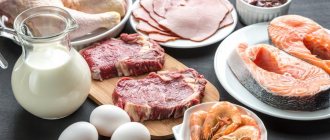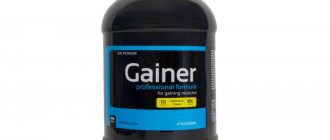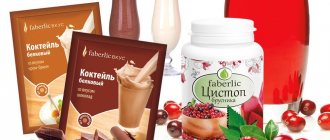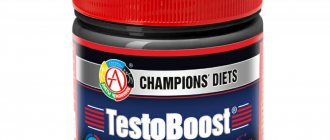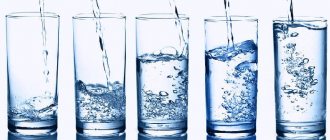If a person who comes to the gym has a clear goal - to build muscle mass, a well-designed training program is not enough. It is necessary to approach the construction of the diet correctly. The menu should be dominated by protein foods, since protein is the main element necessary for building muscle.
Nutrition for Muscle Growth: Basic Principles
The energy expended by a person, replenished by eating food, is directly proportional to physical activity. Strength training requires several times more energy than normal human activity. And if you reduce your diet, the body will begin to experience a lack of nutrients. This will negatively affect both your well-being and the results of your classes.
Following a diet to increase muscle mass does not mean starving, but, on the contrary, consuming more calories than energy expended. This fact should not be taken as the only condition for such nutrition. A diet that promotes muscle gain should be balanced and built on six basic principles:
Fractional meals
You need to eat a lot, but in small portions throughout the day. This promotes the rapid absorption of food for energy, rather than for the accumulation of fat deposits. By eating fractionally, an athlete gains muscle mass rather than fat mass.
High calorie food
Each serving of food you eat should contain a lot of calories. The lower the energy value of food, the more often you will have to eat. About 70% of the daily diet, compiled by the nutrition program, must be made up of high-calorie foods.
Slow fats and carbohydrates
You need to exclude fast carbohydrates and fats from the menu - sweet fruits, confectionery and flour products. They require a long time to digest, which leads to the build-up of fat rather than energy. The body does not have time to spend most of the nutrients extracted from fast carbohydrates and fats to renew the expended energy, but sends it to “storage,” that is, to a fat depot.
Sufficient amount of water
A diet for gaining muscles speeds up metabolism and puts the body into a stressful situation, which can be avoided by following a drinking regime. You need to drink at least three liters of water per day. Failure to comply with this point can lead to dehydration, expressed by deterioration of well-being and stopping the growth of muscle mass.
Diet
Portions eaten before 16.00 should make up the majority of the daily diet. At a later time in the diet, foods with fast carbohydrates and fats should be avoided.
Sports diet
Involves mandatory intensive training. Otherwise, all the calories you consume will turn into fat and not into lean muscle mass. On training days, you need to eat 2 hours before and after training. Accelerating the process of muscle growth is facilitated by additional intake of sports supplements.
Gain muscle mass on a budget.
It's better to overeat unsaturated fats!
Why? Let's look at the results of one study that compared the effects of overeating saturated and unsaturated fats. It is worth immediately clarifying that all dietary sources of fat contain both saturated and unsaturated fatty acids, but, as a rule, some significantly predominate over others.
For 7 weeks, one group of healthy people was overfed with palm oil (saturated fat), the other with sunflower oil (unsaturated). To make these oils easier to consume, they were added to specially baked muffins that participants consumed throughout the day. The degree of surplus and macro diet were the same for everyone. So, as a result, the participants increased their body weight approximately equally, but in those who consumed saturated fats, the increase in the amount of fat in the liver and abdominal cavity was noticeably higher than that in those who consumed unsaturated fats, which was accompanied by an increase in the activity of the corresponding genes in the adipose tissue of these areas. At the same time, in the group of unsaturated fats, the total amount of accumulated fat was slightly less, and the increase in muscle mass was greater (almost three times, although the absolute numbers are small). Scientists have concluded that overfeeding with saturated fats increases the accumulation of liver and visceral fat, and excess energy from unsaturated fats also contributes to the growth of muscle mass.
An increase in visceral fat is associated with a decrease in insulin sensitivity (insulin resistance), as it leads to a decrease in the secretion of adiponectin, which regulates glucose homeostasis. When overeating, insulin resistance is extremely undesirable, as it leads to an increase in the amount of carbohydrates synthesized into fat. And when gaining weight, you have to eat a lot of carbohydrates. We are not talking about deteriorating health now. It turns out that the more fat we gain from excess saturated fat in our diet, the higher our tendency to subsequently accumulate fat.
Overfeeding polyunsaturated and saturated fat causes distinct effects on liver and visceral fat accumulation in humans. Rosqvist F, Iggman D, Kullberg J, Cedernaes J, Johansson HE, Larsson A, Johansson L, Ahlström H, Arner P, Dahlman I, Risérus U. Diabetes. 2014 Jul;63(7):2356-68.
But that is not all. Human adipose tissue stores both saturated and unsaturated fatty acids. The predominance of one or another type of fatty acid in the diet affects which fatty acids we will store. It is important. Why? Research shows that the rate of fat mobilization from fat depots during lipolysis depends on the structure of fatty acids (FAs). It is the highest in the unsaturated ones. The difference with saturated ones can reach 6 times. That is, the unsaturated are mobilized first. This promises us a less difficult parting with fat reserves in the body during the drying period. I quote:
“Fatty acids are selectively mobilized from human fat cells according to molecular structure...By modulating the quality of fatty acid supply to organs and remodeling the fatty acid composition of adipose tissue, this selectivity will have implications for consideration in physiology, public health, and epidemiology.” (Selective release of human adipocyte fatty acids according to molecular structure Thierry RACLOT, Dominique LANGIN, Max LAFONTAN, René GROSCOLASBiochemical JournalJun 15, 1997,324(3)911-915;)
Another quote:
“The release of individual fatty acids from adipose tissue is selective, as determined by in vitro, in vivo, animal and human studies. Typically, fatty acids are more easily mobilized from fat cells when they are short-chain and unsaturated. This selectivity may affect the storage of individual fatty acids in adipose tissue and their subsequent entry into cells (where they are consumed). The nature of dietary fats can influence lipid homeostasis and fat deposition in the body. A diet high in omega-3 polyunsaturated fatty acids (PUFAs) results in a preferential distribution of absorbed energy toward oxidation rather than storage. Fatty acids are important mediators of gene expression in the liver. Genes encoding both glycolytic and lipogenic enzymes, as well as key metabolic enzymes involved in fatty acid oxidation, are regulated by dietary PUFAs.” (Selectivity of fatty acids on lipid metabolism and gene expression. Raclot T1, Oudart H. Proc Nutr Soc. 1999 Aug;58(3):633-46).
The cited work deals not only with the influence of dietary fats on the composition of fatty acids in adipose tissue, but also with their effect on fat metabolism. In particular, Omega-3 fatty acids influence the increase in the degree of oxidation of fats in the liver, which leads to their greater use as a current source of energy rather than a means of storage.
Fats, proteins, carbohydrates: daily intake
A balanced diet is the main condition for success in following a special diet for building muscle mass. This can be achieved by following the principle of an inverted pyramid, which determines the ratio of nutrients in the diet:
- carbohydrates - from 55 to 60%
- proteins - from 25 to 30%;
- fats - from 10 to 20%.
Compliance with this rule requires an accurate calculation of all substances consumed per day. This makes it possible to receive more calories than expended during strength training. The excess goes into muscle mass.
To calculate the daily caloric intake, it is enough to use the following formula: “athlete’s weight” is multiplied by “30”, plus “500” to the result obtained. It should also be taken into account that the ratio of these elements is different for both men and women.
General recommendations
For men
- Squirrels . Some amino acids are synthesized in the body, while other compounds are replenished from the food consumed. And in order to ensure a sufficient amount of protein per day, you need to include protein-rich foods in your diet, for example, meat, milk, fish. The need for a substance is calculated by multiplying your own body weight by two. If an athlete weighs 80 kilograms, then he needs 160 grams of protein per day.
- Fats. Should be reduced, but not eliminated completely. Without them, the body will not be able to function normally. The daily norm is determined by age. Men under 28 need 130-160, men under 40 need 100-150 grams. At a more mature age, the amount is reduced to 70 g/day.
- Carbohydrates . They can be simple or complex. The former are of no value for muscle mass, and the consumption of the latter per day should be at least 500 grams
Women
- Squirrels. The lack of this element negatively affects the appearance of the fair sex. Deficiency leads to deterioration of the condition of the skin, hair structure, and nail plate. Girls, unlike men, need to consume 1.5 grams of protein per 1 kilogram of their own weight.
- Fats. The need for this substance is also determined by age. Up to 28 it is 86-116, up to 40 - 80-111, after 40 years it decreases and amounts to 70 grams per day.
- Carbohydrates. To increase muscle mass, girls need to consume at least 400 grams of slow carbohydrates.
Types of fats or how not to turn into a donut?
In pursuit of six-pack abs and prominent buttocks, many go to extremes, completely abandoning fat-containing foods or consuming large quantities of them. It’s easy to avoid imbalance – just understand the types of fats :
Useful
- Monounsaturated fatty acids found in vegetable oils: peanut, olive, rapeseed, as well as nuts, pumpkin seeds, hazelnuts. They are the main energy producing source of Omega-9;
- Polyunsaturated fats contain elements essential for the body that can only be obtained from food. Omega-3s are found in fatty fish, as well as herring, mackerel, anchovies, flax seeds and flaxseed oil. Omega-6 sources include chicken, turkey, almond, nut and sunflower oils, and soybeans.
Harmful
- Saturated fatty acids, which if consumed in excess will lead to excess weight gain and excess cholesterol. They are contained in foods such as red meat, lard, and milk with a high percentage of fat. Conventionally, they are considered harmful, but it is not recommended to completely exclude them from the diet. And milk and cottage cheese are even welcome at the initial stage of weight gain.
A balanced diet when playing sports involves consuming only 15-20% healthy fat , focusing on carbohydrates and proteins. However, you can adjust this ratio yourself by increasing your intake of carbohydrate foods on training days, and increasing the amount of food rich in fatty acids on rest days. However, remember that the total number of calories should not exceed the daily value calculated with an emphasis on muscle growth. If you want to build muscle and lose weight, then you should reduce the number of calories, but without giving up fat. By following simple rules of food balance and regular strength training, you will soon enjoy the seductive contours of your body.
Permitted and prohibited products
Absolutely any dietary nutrition, including those for increasing muscle mass, involves the inclusion in the diet of products that allow you to fully provide all the nutrients necessary to maintain normal life. For this purpose, athletes can consume both regular food and special supplements.
Along with foods that are beneficial for an athlete gaining muscle mass, there is also food that needs to be excluded from the diet. It does not bring any benefit to the body and is stored in the fat layer. The list of prohibited foods includes the following food groups:
- fatty meats, sausages and sausage products, ham;
- industrial food products containing dyes, flavor enhancers, preservatives and other chemical additives;
- any types of spread, natural butter, mayonnaise, margarine;
- sweet pastries, sweets, cakes, etc.;
- salted, pickled, smoked food.
Protein sources
Protein-rich foods for increasing muscle mass include:
- Chicken or turkey fillet . You need to consume from 150 to 200 grams of this dietary meat per day.
- Dairy products with low fat content. This could be yoghurt and milk.
- Cottage cheese and egg whites. The first, along with protein, also contains valuable microelements. Eggs, for obvious reasons, become a source of protein only without the yolk.
- Sea fish . Salmon, tuna, and so on contain omega acids, which are essential for humans.
- Cereals. Wheat should be consumed sprouted, bread made from whole grain flour, raw or roasted sunflower seeds. You can eat lentils and buckwheat.
Carbohydrate-rich foods
Allows you to obtain the energy supply required for training. The amount of carbohydrates is reduced only for the purpose of losing weight. People gaining muscle mass, on the contrary, need to include the following sources of carbohydrates in their diet:
- brown rice , which contains more carbohydrates than white rice;
- unsweetened types of fruits , reducing the consumption of grapes, pears, bananas;
- vegetables , including herbs and garlic;
- pasta made from durum wheat;
- cereals
Budget diet for gaining muscle mass
The nutrition of any bodybuilder has its own specifics. Typically, professionals carefully control their menu and are selective about adding a certain product. Bodybuilding circles have already developed a list of the most commonly consumed products, the popularity of which is due to affordable prices, the optimal combination of chemical composition, nutritional value and digestibility.
List of basic products for muscle growth for a month:
- Chicken fillet – 3,320 rub.
- Eggs – 1,070 rub.
- Homemade grain cottage cheese – 3,250 rub.
- Pasta made from whole wheat varieties – 300 rubles.
- Oatmeal – 400 rub.
- Greens, vegetables and fruits (lettuce, cucumbers, tomatoes, banana) - RUB 3,350.
- Protein – 3,150 rub.
- Casein — 760 rub.
- Flaxseed oil - 280 rub.
- Broccoli – 1,450 rub.
- Grape vinegar - 450 rub.
Total food expenses for building muscle mass per month are: 17,780 rubles.
Example of a weekly menu
Designed specifically for naturally thin ectomorphs. Provides six meals a day. Portions should be small so as not to overeat and feel hungry. The results of this diet can be seen after a month.
Diet to increase muscle mass
| Day | Eating | |||||
| 1 | 2 | 3 | 4 | 5 | 6 | |
| 1 | Oatmeal, nuts, apple. | Potatoes, chicken fillet, vegetables. | Cottage cheese and banana. | Fish, rice, vegetables. | Tuna with vegetable salad. | Fruit salad. |
| 2 | Orange, nuts, buckwheat porridge with honey and milk. | Boiled pasta, baked veal, vegetables. | Whole grain bread, kefir. | Cottage cheese with honey, kiwi. | Baked mackerel, vegetable salad. | Strawberries, yogurt, peanut butter. |
| 3 | Oatmeal, banana, apple, nuts. | Potatoes, lean veal, vegetables. | Brown bread, omelette, apple. | Smoothie made from milk and fruits. | Turkey fillet, rice, | Jam, cottage cheese. |
| 4 | Rice porridge with milk, nuts, apple. | Vegetable soup, veal. | Whole grain bread, kefir. | Fruit salad. | Turkey fillet, baked potatoes. | Vegetable salad. |
| 5 | Chicken fillet, omelette, vegetables. | Potatoes, lean veal, banana. | Apple, cottage cheese with jam. | Fruit smoothie. | Chicken fillet with vegetable stew. | Strawberries, yogurt, peanut butter. |
| 6 | Nuts, banana, oatmeal. | Chicken fillet, potatoes, vegetables. | Kefir, whole grain bread. | Kiwi, cottage cheese with honey. | Baked mackerel, buckwheat porridge, vegetable salad. | Fruit salad. |
| 7 | Chicken fillet, omelette, vegetables | Veal, vegetable salad, apple. | Banana, cottage cheese with jam. | Fruit smoothie. | Chicken fillet, rice, vegetables. | Vegetable salad. |
Sports nutrition while dieting
A complex schedule or lifestyle does not always allow you to eat up to six times a day. And if such a problem exists, various supplements can come to the rescue to fill the “gaps” in nutrition.
These sports nutrition products include:
Gainers
Contain a large amount of carbohydrates. They allow you to compensate for the lack of calories in the menu and accelerate the process of protein absorption. To prevent unwanted weight gain, you need to drink it 60 minutes before classes, and then after training.
Protein powders
A protein supplement involved in the process of creating muscle mass. It does not interfere with a gainer; it is consumed an hour before training.
Creatine
Retains water in muscle tissue. Drink forty minutes before physical activity.
Be sure to take care of a sufficient amount of vitamins. They not only increase the absorption of nutrients, but also prevent intestinal problems.
Why is bodybuilder nutrition so important for gaining muscle mass?
To effectively grow muscles and increase strength, a bodybuilder's sports diet should consist of plentiful amounts of protein and calories, as well as trace elements and vitamins. For example, for visible muscle growth, an athlete must consume at least 2 g of protein per 1 kg of body weight per day. Carbohydrates are especially important, without which an actively training body will not have enough energy for effective recovery. Moreover, without getting the required amount of calories, the athlete will quickly get tired during weight training.
The more calories consumed, the higher the food costs. Protein-rich foods are especially expensive. Yes, and vitamin food has a hefty price tag. Even if you save on useless food (fast food, smoked foods, sweets, etc.), it is not always possible to provide the required level of nutrition for muscle growth. Prices for poultry, meat and fish will still remain high. Preparing a balanced and varied diet for weight gain every day will not only allow you to get the right amount of proteins, carbohydrates and vitamins, but also save money.

